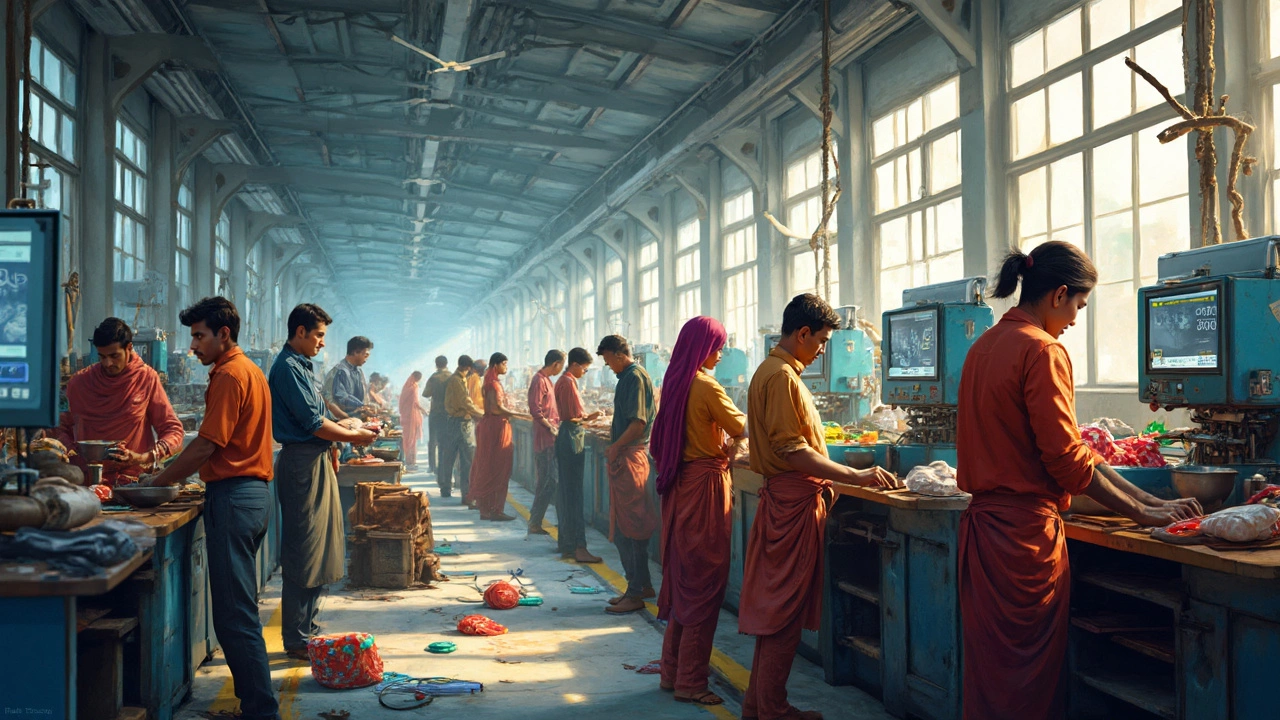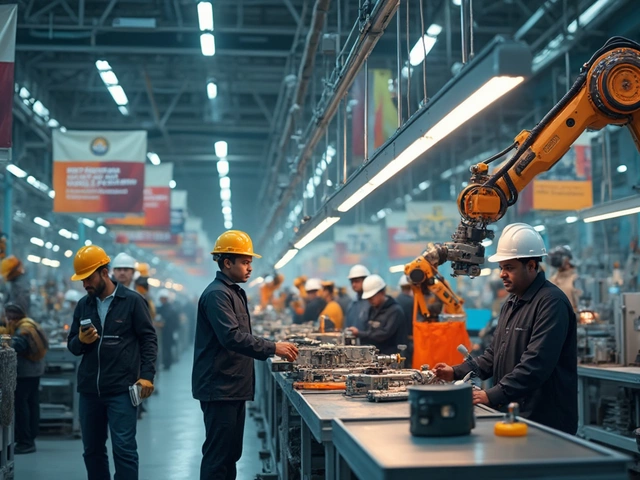If you're poking around the manufacturing world, you keep hearing the term "SME" thrown around. It stands for "Small and Medium-sized Enterprise," but the meaning goes way beyond dry numbers and official categories. SMEs are basically the backbone of the manufacturing scene, whether you're making metal parts, beauty products, or kitchen tools in a garage-sized workshop.
So, why do people care about SMEs anyway? They're everywhere—making up the majority of manufacturing companies you see around town. Most have under 250 employees, and tons of them are way smaller, with less than 50 people plugging away. It’s the difference between a tight-knit team making custom bike frames and a global company pumping out thousands of cars per day. The rules for what’s officially an SME do change a bit from country to country, but usually, it's about staff size and yearly turnover. If you’re running a shop and you’re not sure where your business fits, understanding this can help you hunt down funding, join government programs, or connect with other local factories just like yours.
- The Meaning of SME in Manufacturing
- How to Tell if a Business is an SME
- Why SMEs Matter in Manufacturing
- Tips for Running a Successful SME Factory
The Meaning of SME in Manufacturing
So, what exactly is an SME when you talk about manufacturing? The short answer: it's a business that's not huge—think more family-run machine shop than mega-factory. These businesses don’t get lost in corporate layers. Most SMEs are owner-led, nimble, and deal with everything from small batch parts to niche consumer goods. They tend to hire the folks you see at the coffee shop instead of thousands of people across the world.
To get a clearer picture, here's how SMEs get officially defined in most countries:
- They have fewer than 250 employees. The majority of small manufacturers actually run with fewer than 50.
- Annual sales (turnover) cap out at a set amount—usually around $50 million USD, but often less in many countries.
- They’re independent—not part of a bigger company or group that could finance them at a massive scale.
You might wonder how this stacks up in real numbers. Take a look at this:
| Type | Employees | Annual Revenue (Approx.) |
|---|---|---|
| Small Enterprise | < 50 | Up to $10 million |
| Medium Enterprise | 50–249 | $10–50 million |
Now, numbers are just part of the story. The heart of the SME way is being flexible. Big manufacturers crank out millions of the same part. SMEs might do one-off custom orders or limited runs, filling in gaps that the giants ignore. Plus, small businesses take more chances—they’re often the first to try a new process, tool, or digital gadget in the shop.
Don’t confuse SMEs with “mom-and-pop” shops that only tinker in their spare time—plenty of SMEs land contracts with major brands, supply regional markets, or run advanced production lines. The size just means they keep things focused and hands-on.
How to Tell if a Business is an SME
If you’re trying to figure out if your business—or someone else’s—counts as an SME in manufacturing, there are a couple of fixed things to look at: headcount and yearly money coming in, called turnover. Most countries have their own take on these rules, but there’s a handy pattern you can follow.
In Europe, the official numbers say a small business has fewer than 50 employees and less than 10 million euros in yearly turnover. A medium one sits between 50 and 249 employees, with up to 50 million euros coming in each year. In the U.S., the standards get set by the SBA (Small Business Administration), and they often talk about average employees over a year—a small manufacturing business usually means 500 workers or less. That’s bigger than most people picture, right?
Here’s a side-by-side to make it clearer:
| Category | Europe (EU) | United States |
|---|---|---|
| Small | < 50 employees < €10M turnover |
<= 500 employees* |
| Medium | 50-249 employees < €50M turnover |
Varies, but above 500 usually counts as large |
*The U.S. number changes a bit based on your industry code, but 500 is the default for manufacturing.
Besides these main numbers, some places also factor in total assets, but that’s less common for basic manufacturing.
If you’re not sure where you land, just count your staff and check your yearly sales. If you’re making products and your team is well under 250 people, you’re pretty much an SME. Don’t overthink it—government programs and banks aren’t looking for hidden numbers. If your business gets close to these limits, double-check with your local rules. And remember, the size brings some perks, like easier access to grants and less red tape. Knowing your category means you can tap into support designed just for small scale manufacturing companies.

Why SMEs Matter in Manufacturing
SMEs hold way more weight in manufacturing than most people think. In a lot of countries, these small and medium businesses make up over 95% of all manufacturing firms. That’s not just a fun fact—these companies genuinely drive the industry forward. In the European Union, for example, SMEs account for about two-thirds of industrial jobs. In the US, over 250,000 manufacturing SMEs employ nearly 8 million people. So yeah, they're a big deal.
What makes SMEs so important? For starters, they’re often more flexible than big corporations. If a new material hits the market or a trendy product takes off, SMEs can jump on it. They’re usually quicker with upgrades and not bogged down by layers of management. That means more room for creative thinking and specialized products. Ever seen a cool new gadget on Kickstarter? Chances are, an SME made it happen before the big brands caught on.
Economically, these businesses spread opportunity. You see them in small towns and city neighborhoods, where they often give people jobs close to home. Here’s a look at their impact in numbers:
| Region | % of All Manufacturing Firms | % of Industry Jobs |
|---|---|---|
| European Union | Over 99% | 66% |
| United States | ~98% | 43% |
| India | About 95% | Over 30% |
Plus, SME manufacturing businesses have a big influence on supply chains. They supply parts, materials, or finished products to larger companies. If local SMEs struggle or close, bigger brands feel the pinch too.
- They offer niche products and custom solutions.
- They keep competition healthy by offering alternatives to big brands.
- They often kickstart innovation thanks to their ability to experiment with new ideas.
Governments care about SMEs too, often rolling out perks like tax breaks or training programs to help them thrive. It’s no exaggeration—without SMEs, manufacturing as a whole would look completely different.
Tips for Running a Successful SME Factory
If you’re running a SME in manufacturing, you can’t just copy what the big players do. You need down-to-earth, sharp strategies that fit your size and budget. Here are some proven ways to boost your odds of staying profitable (and sane).
- Keep a Steady Eye on Cash Flow. When you run a small shop, a late payment can feel like a punch in the gut. Use accounting software that tracks your invoices, expenses, and inventory in real time. The UK Federation of Small Businesses reports that 50,000 small businesses shut down every year because of late payments—don’t be one of them.
- Invest in Your Team. Got a small crew? Treat them like gold. Regular training, open communication, and small perks make all the difference. German SMEs with ongoing training programs see 24% higher productivity, according to a 2021 study by Fraunhofer Institute.
- Embrace Smart Tech—But Be Picky. Not every tech upgrade makes sense. Tools like cloud-based inventory apps, affordable sensors for quality checks, or simple lean manufacturing systems can save you hours and catch mistakes before they cost real money. Start small and scale up what actually helps.
- Build Strong Local Partnerships. Whether it’s teaming up with other local shops on bulk orders or swapping tips with folks in your industry, building partnerships pays off. Suppliers are often more flexible with SMEs they know personally.
Check out how some real-world factories balance these things:
| SME Type | Common Staff Size | Top Focus |
|---|---|---|
| Metal Part Workshop | 12 | Flexible machinery, repeat customers |
| Local Food Producer | 25 | Consistent quality, quick delivery |
| Handmade Soap Factory | 9 | Online sales, unique recipes |
Last tip—stay close to your numbers. Review your best-selling products and costs at least once a month. It’s easy to chase new projects, but if a product line isn’t making money, don’t be afraid to pivot or scrap it. That’s the beauty of an SME: you can move fast and make changes without a dozen board meetings.





